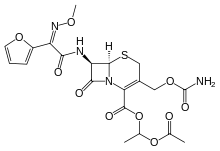Cefuroxime axetil
Cefuroxime axetil, sold under the brand name Ceftin among others, is a second generation oral cephalosporin antibiotic.
 | |
| Clinical data | |
|---|---|
| Trade names | Zinnat, Ceftin, Ceftum |
| Other names | Cefuroxime 1-acetoxyethyl ester |
| Routes of administration | Oral, IV, IM |
| Legal status | |
| Legal status |
|
| Pharmacokinetic data | |
| Bioavailability | well absorbed |
| Metabolism | Cefuroxime is not metabolized, Axetil is metabolized to acetaldehyde and acetic acid. |
| Excretion | Urine |
| Identifiers | |
| |
| CAS Number | |
| PubChem CID | |
| ChemSpider | |
| UNII | |
| ChEMBL | |
| CompTox Dashboard (EPA) | |
| ECHA InfoCard | 100.166.374 |
| Chemical and physical data | |
| Formula | C20H22N4O10S |
| Molar mass | 510.47 g·mol−1 |
| 3D model (JSmol) | |
| |
| |
It is an acetoxyethyl ester prodrug of cefuroxime which is effective orally.[1] The activity depends on in vivo hydrolysis and release of cefuroxime tablets.
It was patented in 1976 and approved for medical use in 1987.[2]
Medical uses
Second generation cephalosporins are more effective in treating Gram-negative bacilli compared to first generation cephalosporins, which have a greater coverage for Gram-positive cocci. Also, it has been reported that cefuroxime is resistant to hydrolysis by β-lactamases produced by Gram-negative bacteria.[3]
Upper respiratory tract infections.
Lower respiratory tract infections.
Skin and soft tissue infections.
Early Lyme disease.
Bacterial susceptibility
Cefuroxime axetil treats infections against methicillin, oxacillin and penicillin-sensitive bacterial strains. Cefuroxime axetil does not work against enterococci. [4]
Gram-positive aerobic microorganisms
Staphylococcus aureus (Methicillin-sensitive only)
Streptococcus pneumoniae (Penicillin-sensitive only)
Gram-negative aerobic microorganisms
Klebsiella pneumoniae (variable acitivity)
Mechanism of action
Cefuroxime axetil, as a second generation cephalosporin ;that just as penicillins antibiotics, contains a β-lactam ring structure. Cephalosporins works as a bactericidal antibiotic; that by binding to penicillin-binding proteins (PBPs), inhibit the last step of the bacterial cell wall synthesis. Once the β-lactam ring binds to PBPs, cross-linking between peptidoglycan units is inhibited.[3]
Pharmacokinetics
Absorption: Once consumed, cefuroxime axetil is converted to the active compound cefuroxime by esterases of mucosal cells in the gastrointestinal tract. Cefuroxime is then released for systematic circulation. If cefuroxime axetil is given with food, absorption values can increase by 52% compared to fasting patients.[4]
Distribution: It has been reported that after cefuroxime axetil administration, it can be found in tonsil tissue, sinus tissue, bronchial tissue and middle ear effusion.[4]
Elimination: After cefuroxime production, the body is unable to metabolize the drug, and is eliminated unchanged in the urine.[4]
History
It was discovered by Glaxo now GlaxoSmithKline and introduced in 1987.[6] It was approved by FDA on December 28, 1987.[7] It is available by GSK as Ceftin in US[8] and Ceftum in India.[9]
See also
References
- Walter Sneader (2005-06-23). Drug Discovery: A History. John Wiley, Chichester, UK. ISBN 0-471-89979-8.
- Fischer J, Ganellin CR (2006). Analogue-based Drug Discovery. John Wiley & Sons. p. 494. ISBN 9783527607495.
- Bui T, Preuss CV (2020). Cephalosporins. StatPearls. StatPearls Publishing. PMID 31855361. Retrieved 2020-04-23.
- Perry CM, Brogden RN (July 1996). "Cefuroxime axetil. A review of its antibacterial activity, pharmacokinetic properties and therapeutic efficacy". Drugs. 52 (1): 125–58. doi:10.2165/00003495-199652010-00009. PMID 8799689.
- GlaxoSmithKline (2015). "Ceftin (cefuroxime axetil)" (PDF). FDA. Retrieved 22 April 2020.
- "Our history - About GSK". GlaxoSmithKline. Archived from the original on 2011-05-14.
- "Cefuroxime Axetil Monograph for Professionals". Drugs.com. Retrieved 2018-04-22.
- "Brands". Gsksource.com. 2018-03-22. Retrieved 2018-04-22.
- "Our products". GlaxoSmithKline.